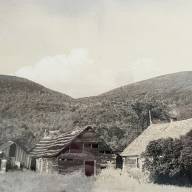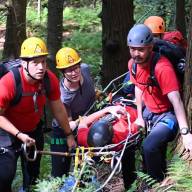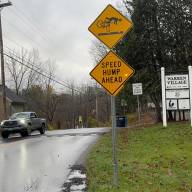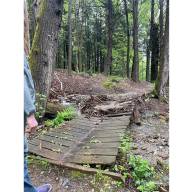On September 12, Mad River Valley Arts held a panel discussion at the MRV Arts gallery with four local art experts to discuss art collecting and the role of patronage within the Vermont to global art ecosystem. The discussion, with questions from the audience, included how to determine what art to add to one’s collection. The panelists shared their practices in reading and seeing art in a particular way which informs their collecting philosophy.
Edee Simon, collector and board member at The Current in Stowe, talked about her travels and discovering that the local art wherever she was “informed her art appreciation.” Her advice when looking at a piece of art in the context of developing one’s art collecting practice is to seek out one’s own response to a work, that perhaps the work should inspire having a conversation with it, saying, “Don’t read the explanation on the wall next to it before you look at it.” Another board member at The Current, Paul Hertz, agreed, “there should be a list of questions next to the artwork rather than an explanation.”
Mark Waskow of the Northern New England Museum of Contemporary Art sees art as a process that creates a fossil, and asks, “can you see the hand of the artist in the work?” Hertz advised that those considering purchasing a piece of art consider that “it has to talk to you and continue to speak to you over time and you have to imagine that you can be on good terms with it for the years to come.”
There was considerable discussion about art as a contributor to the state’s economy. Amy Cunningham, deputy director of the Vermont Arts Council, stated that the cultural sector is third behind retail and construction in terms of dollars added to the economy, contributing $1.2 billion to the economy in 2022. On the other hand, Simon points out that the art ecosystem has a problem in that it only promotes very expensive art. And Waskow noted, “Our private economy supports art but doesn’t provide enough dollars to support artists.” Both Waskow and Cunningham agreed that more public art is needed everywhere.” There is a high percentage of Vermonters who think art is important,’ Cunningham noted, then added, “threats to arts education, including in higher education, will have a negative impact on the creative sector in our state.”
Sam Talbot-Kelly, executive director of Mad River Valley Arts, pointed out that MRVA is sensitive to the needs of its audience and provides tools visitors can use to engage with the art. The organization aims to matter to the community and provide relevant exhibition content in inventive and sustainable ways. She asks, “how are we evolving and contributing to our culture?” The organization is planning projects that will create collaborations with other artists and organizations in The Valley. The recording, Mad River Valley Arts Presents: “What’s in Your Art Collection?” is available on YouTube. A follow-up panel discussion is planned.
The Wild Pink Exhibition is open Tuesday through Saturday, 1 to 5 p.m. until October 31.













